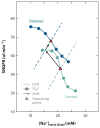Renal function in diabetic disease models: the tubular system in the pathophysiology of the diabetic kidney
- PMID: 22335797
- PMCID: PMC3807782
- DOI: 10.1146/annurev-physiol-020911-153333
Renal function in diabetic disease models: the tubular system in the pathophysiology of the diabetic kidney
Abstract
Diabetes mellitus affects the kidney in stages. At the onset of diabetes mellitus, in a subset of diabetic patients the kidneys grow large, and glomerular filtration rate (GFR) becomes supranormal, which are risk factors for developing diabetic nephropathy later in life. This review outlines a pathophysiological concept that focuses on the tubular system to explain these changes. The concept includes the tubular hypothesis of glomerular filtration, which states that early tubular growth and sodium-glucose cotransport enhance proximal tubule reabsorption and make the GFR supranormal through the physiology of tubuloglomerular feedback. The diabetic milieu triggers early tubular cell proliferation, but the induction of TGF-β and cyclin-dependent kinase inhibitors causes a cell cycle arrest and a switch to tubular hypertrophy and a senescence-like phenotype. Although this growth phenotype explains unusual responses like the salt paradox of the early diabetic kidney, the activated molecular pathways may set the stage for tubulointerstitial injury and diabetic nephropathy.
Figures




References
-
- Ziyadeh FN, Wolf G. Pathogenesis of the podocytopathy and proteinuria in diabetic glomerulopathy. Curr Diabetes Rev. 2008;4:39–45. - PubMed
-
- Jerums G, Premaratne E, Panagiotopoulos S, Macisaac RJ. The clinical significance of hyperfiltration in diabetes. Diabetologia. 2010;53:2093–104. - PubMed
-
- Magee GM, Bilous RW, Cardwell CR, Hunter SJ, Kee F, Fogarty DG. Is hyperfiltration associated with the future risk of developing diabetic nephropathy? A meta-analysis. Diabetologia. 2009;52:691–97. - PubMed
Publication types
MeSH terms
Substances
Grants and funding
LinkOut - more resources
Full Text Sources
Medical

